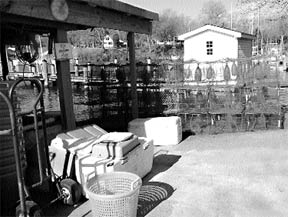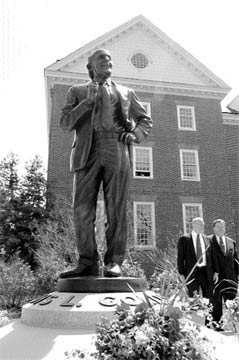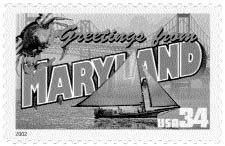|
|
 |
Stricter crab regulations and mixed indicators as to the population’s overall health may put the pinch on Maryland crabbers, who began setting their pots with the opening of the season April 1.
photos by Brent Seabrook
|
Bring on the Seasoning: Crab Season’s Open
The table’s set and the dinner bell’s rung, but if there’s crab on the plate, it came from Louisiana.
Crab season officially began in Maryland April 1, but Chesapeake Country watermen are taking that about as seriously as they would an April Fool’s prank. On the Bay, at least, Mother Nature trumps.
Most watermen are waiting for warm water to tease the crabs from their hiding places in the mud and murk.
“They don’t start moving till around the 15th,” said Captain Larry Simns, director of the Maryland Watermen’s Association.
Simns was talking about the crabs, of course, for crabbers never rest. In winter, while the crabs are snug in the mud, the crabbers clean their boats and powerwash their pots. This week, a ready few have taken their boats around to Ocean City, where the waters warm sooner. Rick Edmund, of Smith Island, heard that crabbers in Chincoteague Bay caught their limit on opening day.
On the Bay’s Eastern Shore, Wye River Seafood also brought in its timely first bushel.
Last fall’s outlook was gloomy, but what is spring if not optimistic?
“There were some hopeful signs in the trawl survey performed by the Virginia Institute of Marine Science toward the end of last season,” said Jack Greer, at the University of Maryland Sea Grant College, “and this may bode well for the coming year.”
Other positive signs, the scientist reported, include “last year’s abundance of small crabs around Smith and Tangier islands, and a number of really large crabs caught at the end of the season there.”
Cold weather kills many crabs that haven’t burrowed deep enough, but more than usual may have survived this mild winter.
Hints of impending bounty are easing some of the anxiety created by Maryland’s strict new regulations. The regulations increase the minimum legal size of soft and peeler crabs — and males after August 1 — and ban outright the possession of egg-bearing females.
“They’re losing a size in the soft crabs,” Smith Islander Edmund said.
Meeting recently at Department of Natural Resources, Edmund heard a crab-meat packer worry that it wasn’t just the mediums that could be lost. If Maryland can’t supply medium crabs, wholesalers might cancel entire orders rather than procure mediums separately.
For an economy like Smith Island’s, where 90 percent of the population depends on crabbing for survival, such changes could be disastrous. Edmund, who is also a minister, said the community came together for a 36-hour prayer vigil over the Easter weekend. “We prayed for safety on the water and for a good harvest,” he said.
Still, Greer believes the new regulations will prove sound in the long run.
“When all the numbers are tallied up, good and bad, we are still far below the long-term average,” he said. “The current plan to reduce fishing pressure by 15 percent is meant to be precautionary and to protect the spawning stock if it turns out that the population continues to drop. With any luck, a combination of natural trends and reduced fishing pressure will put more crabs in the Bay and on our picnic tables in the coming year or two. But at this point it’s anybody’s guess.”
Scientists won’t offer any solid predictions about the harvest and resulting crab prices until the results of the winter dredge survey are out, but that doesn’t stop workers in the industry offering their two cents.
“This season’ll be like every other,” said Rob Frasar, of Cantler’s Seafood in Annapolis. “Everybody’ll start talking about how this is the worst harvest ever, and that’ll jack the prices up. Then they’ll bring in a mess of crabs, and the prices won’t come down.”
So how high will prices get?
“As high as people’ll pay,” Frasar said. “You never can tell. Every year is different. It’s like the new season for the Orioles. Who knows how they’ll do? Or when you fish — sometimes the fish’re there and sometimes they’re not, and you have no idea why.”
— Brent Seabrook
 |
Mr. Maryland, Louie Goldstein, in bronzed likeness outside the doors of the state Treasury Building where he served as comptroller for nearly 40 years.
photos by Brent Seabrook
|
The Return of Mr. Maryland: Louie Goldstein Unveiled
Hundreds of people gathered this week to remember a man they knew either on a first name basis, as Louie, or as Mr. Maryland. The politician nearly everybody loved couldn’t be there himself, having died at the age of 85 in 1998, but the unveiling of a statue in his likeness is just the kind of event Louis Goldstein would have appreciated. In life, he never missed such an opportunity to shake hands, pass out his trademark gilded coins and offer his familiar greeting, “God bless you all real good.”
As he did in life, Louis Goldstein stands out in a city where statues of politicians are scarce.
Born in Prince Frederick as the son of immigrants, Goldstein made politics his career. From 1939 to his death in 1998, he was out of office only during his four years of combat duty in the Pacific with the U.S. Marine Corps. Elected as a delegate in 1939, the veteran returned to politics, first as house majority leader, then as senator, finally as president of the senate. But most Marylanders knew him as what he seemed to be: Maryland’s comptroller for life. He held that job from 1959 until his death nearly 40 years later, becoming the longest-serving state official in Maryland history.
Maryland’s treasury building is named after him, as is wide, scenic Route 2/4 when it enters Louie’s home county of Calvert.
The unveiling was appropriately formal, but the crowd exuded a palpable affection for the late comptroller. Fellow Calvert Countian Robert Swann — a former aide who completed Goldstein’s term — welcomed everyone and thanked Louis for the warm weather.
“I’m sure he has some pull up there,” he said, glancing at the cerulean sky.
A Naval Academy color guard presented the flags of state and nation, and the crowd rose as Calvert County’s Patuxent High School Band roared through a vigorous but dignified national anthem. Swann introduced Goldstein’s family, friends and supporters, and Joseph Brown of Bible Way Church, in Prince Frederick, offered a prayer. Then praises poured forth.
“On his worst day,” Swann said, “Louis Goldstein had more enthusiasm for life than most of us have on our best days. He had a lifelong love affair with the people of Maryland.”
Gov. Parris Glendening lauded in Goldstein a warmth that critics say the governor lacks. “If he didn’t remember you, he implied he remembered you,” Glendening said. “You thought he remembered you. He was an extraordinary man, but also an everyman — and an everywoman.”
Lieutenant governor Kathleen Kennedy Townsend noted that Goldstein was the first Democrat to endorse her when she entered the political arena.
State senate president Mike Miller lightened the tone. “The mind can only absorb what the seat can endure,” he said, quoting Goldstein and promising to keep his remarks brief. Flush with the Terrapins’ NCAA championship, Miller recalled Goldstein’s dedication as a fan of the University of Maryland’s sports teams. And he painted a picture of the late comptroller in the afterlife, passing out “those damn gold coins” in a red Fear the Turtle shirt.
Speaker of the house Casper Taylor described Goldstein as “the quintessential public servant,” provoking a nod from Louie’s otherwise impassive successor, comptroller and former governor — as well as Baltimore mayor — William Donald Schaefer.
When Louie’s family took their turn, daughter Louisa Goldstein quoted The Bond Buyer — the self-proclaimed daily authority of public finance — styling her father “a triple-A kind of guy.” In the bond business, triple-A is the highest credit rating.
Then it came time for the statue. Louisa joined her brother Philip and her sister Margaret to tug at a long cord, and the likeness of their father emerged from beneath its heavy veil. The audience clapped, and the black-tied band played a sonorous Maryland, My Maryland.
Pleading laryngitis, Minister Brown had his wife, Pearl, bless the statue before the color guard retired, leaving the crowd to press close.
The statue was fashioned by Jay Hall Carpenter of Gaithersburg, already known as the creator of sculptures that adorn the National Cathedral. He worked from hundreds of photographs, video tape and Goldstein’s actual clothing.
Carpenter’s attention to detail brought Mr. Maryland to life
He stood hand on hip in the spring sunlight, bronze brow gleaming. His clothes were rumpled, his tie askew, and a smile creased his face. With his free hand, he offered a coin to his adoring constituents.
One of the original coins, inscribed “Louis L. Goldstein, Comptroller,” on one side and “God Bless You All Real Good” on the other, was buried beneath the statue.
— Brent Seabrook
 Along Western Shore, Trees Need Homes Along Western Shore, Trees Need Homes
Somebody had better tell the shoreline they’re coming. On Earth Day, clusters of organized volunteers will meet at 10am at the Anne Arundel County Library in Deale to pick up free saplings, grab their shovels and scatter across Southern Maryland to plant trees. No one knows exactly how many will be planted or where their roots will take hold. That’s up to you.
“Rather than say to the community ‘you need trees,’ we’re asking the communities who want trees to let us know and we’ll get them, distribute them and show people the proper way to plant them,” said Peg Burroughs, outreach and education coordinator for the Lower Western Shore Tributary Team.
The planting, as part of the state-wide Adopt-A-Stream Program, asks Southern Marylanders to decide how many trees their community needs and where to plant them. All it takes is a little organization and some shovels.
“I think it’s a very good thing we’re doing,” said community activist Tom Gill of Rose Haven. “So many things we do are not appropriate if you want to protect the Bay. Trees keep a lot of dangerous pollutants out of the water.”
With its spindly little branches and its timid roots, a sapling might not look impressive, but it can make a difference. “All the time it’s growing it’s absorbing stuff from the land,” Burroughs said. “It’s branching out its little roots that are holding stuff from falling into the water.”
Runoff contains chemicals from air pollution and nutrients from fertilizers. The mixture can stimulate algal blooms and cloud the water, killing underwater grasses that support aquatic life. Trees and shrubs help curb runoff and reduce erosion, protecting the Bay’s health. The planting is especially important in communities that have common property running down to the water’s edge.
But how will shoreline residents who care about the Bay still enjoy their beautiful views with trees in the way? They can plant shrubs or vines instead. So far, the plan is to purchase pin oaks, red osier dogwoods, river birches, sycamores, green ashes and silky dogwoods. If volunteers call in soon enough, they may get shrubs or vines as well.
No matter how many trees spread their roots on April 20, neighbors will get together, get dirty and make a difference. That’s all the incentive Gill needs. “I will put on my boots and my old clothes,” he says, “and get all muddy and feel virtuous.”
Need trees? 410/867-0366.
— Davene Grosfeld
New ‘Greetings from Maryland’
You can skip the postcard when you send ‘wish you were here’ greetings from Maryland. That’s because starting this week, you can buy a stamp that says it all.
 This stamp is such a package that it’s even got a name. Greetings from Maryland — issued April 4 by Gov. Parris Glendening and Annapolis Mayor Ellen Moyer — was inspired by tourist postcards of the 1930s and ’40s. These cards depicted local scenes inside the large letters that spelled out the name of the place or attraction. This stamp is such a package that it’s even got a name. Greetings from Maryland — issued April 4 by Gov. Parris Glendening and Annapolis Mayor Ellen Moyer — was inspired by tourist postcards of the 1930s and ’40s. These cards depicted local scenes inside the large letters that spelled out the name of the place or attraction.
Greetings from Maryland is made up of a crab, a skipjack and the Bay Bridge. On the flipside of the no-lick sheet of stamps are the state bird, flower, tree, capital city and state of statehood.
But on size, Greetings from Maryland falls short of the original. It’s just one piece of a ‘postcard’ of 50 self-stick stamps in a United States stamp collage with one one stamp for each state in the Union.
All together, Greetings from is big and pretty, but it’s not cheap: At 34 cents each, this sheet of 50 Greetings costs $17, which may explain why this is the first time in a decade the United States Postal Service has issued panes of 50 stamps. And, if you decide to use the stamps, you’ll destroy the collage as you rip it apart into 50 pieces.
See Greetings from at your postoffice or at www.usps.com/shop under Collector’s Corner/Release Schedule.
— Bay Weekly
Way Downstream …
Along Chesapeake Bay, scientists are trying to solve what the latest issue of Bay Journal calls a “baffling ecological mystery” — Why are so many rockfish turning up with lesions caused by the uncommon disease mycobacteriosis? …
In Washington, a new permit has been issued to an unlikely Potomac River dumper: the Army Corps of Engineers. The five-year permit, criticized by conservationists, allows the Corps to dispose of heavy concentrations of sediments removed from drinking water …
In Wisconsin, researchers report that the Baraboo River is fast returning to normal since the final dam was removed last fall to restore natural river conditions. The number of species of fish has more than doubled, and wildlife not seen recently has returned to the 120-mile, free-flowing river, one of the biggest undammed river stretches in America …
In Greece, local officials are so concerned about drought there that they asked the 2004 Olympic organizers last week not to plant thirsty trees in Athens. Organizers have said that they intend to plant one million trees to green semi-arid Athens for the summer games …
In Nepal, people responded to Japan’s economic assistance with a surprising gift: a pair of endangered Indian rhino calves. Just 2,000 remain in the world because of poachers who sell their horns as daggers and aphrodisiacs. They have taken up residence at Tokyo’s Tama Zoological Park …
Our Creature Feature comes from New Zealand, where researchers have discovered what might be the largest octopus ever seen: a behemoth with a 13-foot-long body brought up from the depths in remote waters off windswept islands of the South Pacific.
Not only was it big, it was amazing to behold: bright red with a jelly-like body, Reuters reported. Researcher Steve O’Shea pointed to the possibility of more such discoveries. “This is an area which is so poorly explored that it’s not surprising that we’re getting all these weird and wonderful animals.”
Copyright 2002
Bay Weekly
|